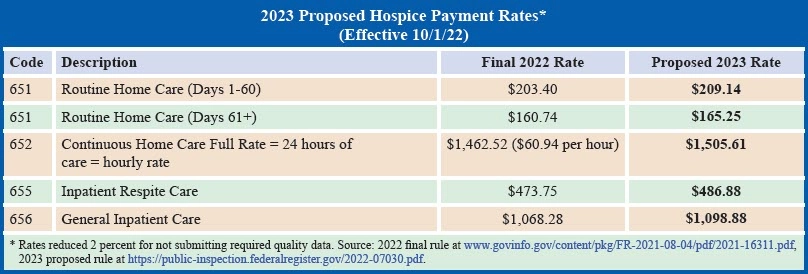Pay Hike, Wage Index Change On Deck For 2023
Medicare plans to boost hospice pay rates 2.7 percent. Hospices may not be getting all they’d like when it comes to wage index methodology revisions, but the first major revamp in years would still help them out. Background: Hospices have long complained about drastic swings in wage index amounts from year to year, which can significantly impact the payment rates agencies ultimately receive from Medicare. (As a reminder, the Centers for Medicare & Medicaid Services multiplies the labor portion of the Medicare payment rate by an agency’s wage index amount to calculate the final rate of pay.) But CMS hasn’t taken any long-term action on the issue. “In the past, we have established transition policies of limited duration to phase in significant changes to labor market areas,” CMS acknowledges in the hospice proposed payment rule for 2023 released March 30. For example, when implementing new Office of Management and Budget delineations for wage index areas, CMS capped the first year of changes at 5 percent for 2021, but then let the rest of the difference take effect in 2022, even if it was more than 5 percent. When it is a single wage index area that sees a big swing, rather than a system-wide change, CMS allows no protective policy against the drastic difference. But the agency now aims to change that. “Certain changes to wage index policy may significantly affect Medicare payments,” CMS acknowledges in the rule scheduled for publication in the April 4 Federal Register. “Changes to the wage index have the potential to create instability and significant negative impacts on certain providers even when labor market areas do not change,” CMS continues. “In addition, year-to-year fluctuations in an area’s wage index can occur due to external factors beyond a provider’s control, such as the COVID-19 [public health emergency], and for an individual provider, these fluctuations can be difficult to predict.” Bottom line: “We … recognize that predictability in Medicare payments is important to enable providers to budget and plan their operations,” CMS acknowledges. “In light of these considerations, we are proposing a permanent approach to smooth year-to-year changes in providers’ wage indexes,” CMS announces. “We are proposing a policy that increases the predictability of hospice payments for providers, and mitigates instability and significant negative impacts to providers resulting from changes to the wage index.” More specifically, that policy is to cap any wage index decreases from one year to another at 5 percent, “regardless of the underlying reason for the decrease,” CMS notes in its fact sheet about the rule. “There are circumstances that a one-year mitigation policy, like the one adopted for FY 2021, would not effectively address future years in which providers continue to be negatively affected by significant wage index decreases,” CMS admits. The regulatory change shouldn’t shake up reimbursement overall, CMS believes. “Typical year-to-year variation in the hospice wage index has historically been within 5 percent, and we expect this will continue to be the case in future years,” the rule notes. It should “have a very small effect on the wage index budget standardization factors for FY 2023” and “would continue to maintain the accuracy of the overall labor market area wage index system,” the agency judges. And the change will be budget-neutral, CMS adds. Providers and their representatives are happy to see CMS finally take some action on this problem. “The wage index change is very welcome,” says Theresa Forster with the National Association for Home Care and Hospice. “We have expressed serious concerns over the years regarding the significant financial hardships that some providers have been subjected to by way of routine changes to the wage index values, so we are pleased that CMS sees the wisdom in taking action to mitigate the negative impact of these changes on a permanent basis,” says NAHC President Bill Dombi in prepared comments. “The cap on wage index decreases is long overdue,” assesses finance expert Mark Sharp with BKD in Springfield, Missouri. “It will go a long way towards fixing the huge wage index decreases that happen in random CBSAs from time to time, which are unpredictable and unfair to hospice providers in those CBSAs. This proposed change will allow for more predictability in rates from year to year,” Sharp expects. However: “It would be better if the cap amount was less than 5 percent, though,” Sharp tells AAPC. “A 5 percent decrease is still pretty steep,” he points out. But the cap is “a definite improvement,” he allows. Another however: “We still believe that additional action needs to be taken to level the playing field given that hospice providers — and home health providers, as well — compete for many of the same disciplines as hospitals do,” Forster maintains. Specifically, “the wage index system should be overhauled so that the same index and adjustments are available to all providers who are competing for the same labor pool,” Forster explains. “Right now hospitals may seek reclassification and are also subject to a rural floor, items that other providers may not have access to. As a result … hospitals may have significantly different wage index values applied to their payments than other providers in the same area,” Forster tells AAPC. In fact, commenters on previous hospice and home health rules have called for systemic changes to help agencies compete with other employers in their area. Geographic reclassification, such as is available to hospitals, is one example. The hospice rule is mum on that topic, however. Hospices have a chance to tell CMS their views on that and other subjects, with comments due May 31. HQRP Penalty Set To Climb Meanwhile, CMS proposes a 2.7 percent increase to hospices’ Medicare payment rates. That derives from an estimated 3.1 percent inpatient hospital market basket update reduced by a mandated productivity adjustment of 0.4 percent. If finalized, the 2.7 percent pay bump would result in an additional $580 million in hospice spending in 2023, CMS expects. The 2.7 percent increase also applies to the aggregate per beneficiary cap amount, which is proposed to climb to $32,142.65, up from $31,297.61 this year. (See rates by care level in chart above). While the 2.7 percent figure is healthy compared to some past years’ updates, Sharp is surprised it isn’t even higher. “We’ve all heard about the significant inflation happening in the U.S. right now,” Sharp says. “The inflation in the U.S. Consumer Price Index (CPI) for all items was 7.9 percent from February 2021 to February 2022,” he highlights. “That’s what so many are feeling right now.” That might lead you to expect a higher update for Medicare rates. “But if you look deeper, the inflation in CPI specific to medical care commodities and medical care services was only 2.5 percent and 2.4 percent, respectively, for the same time period,” Sharp points out. “That makes the proposed market basket increase look much more reasonable.” Still “hospice providers are experiencing much higher increase in costs due to inflation, gas prices, staffing cost increases and ongoing COVID expenses,” protests the National Hospice and Palliative Care Organization’s Judi Lund Person. “More is needed to address some of the increases in expenses among hospices,” Lund Person tells AAPC. Don’t write the 2.7 percent pay bump in permanent ink, however. “The hospital market basket update and the productivity adjustment values are subject to change and will likely be adjusted in the final hospice payment rule which will be issued this summer,” NAHC points out. “It will be interesting to see if the inflation in the medical care items starts to pace more with the many other areas seeing very high inflation,” Sharp muses. If so, you may expect your pay rate to go up. Don’t forget: Hospices that failed to submit required Hospice Quality Reporting Program data in 2021 will face a 2 percent decrease to their rates in 2023. But in 2024, that penalty increases to 4 percent based on HQRP data submitted in 2022. Note: Links to the 22-page rule, including instructions on submitting comments, and the proposed wage index are at https://www.cms.gov/medicaremedicare-fee-service-paymenthospicehospice-regulations-and-notices/cms-1773-p.


